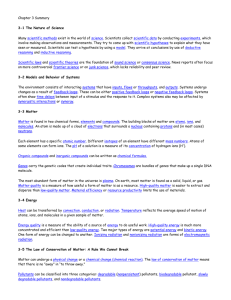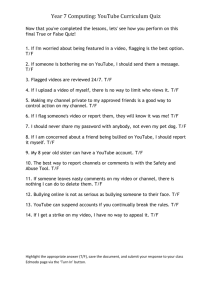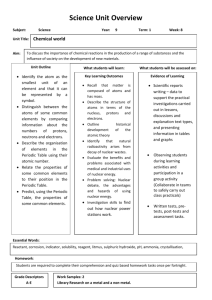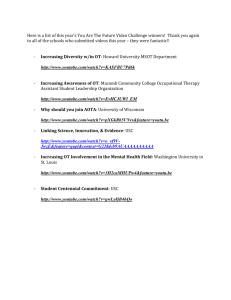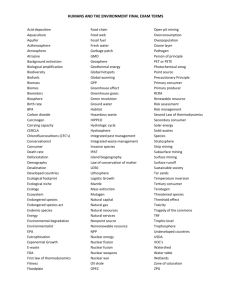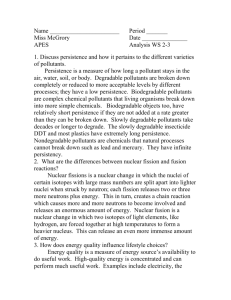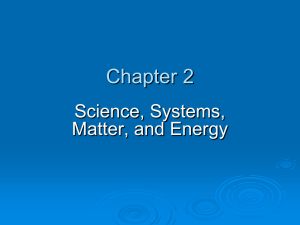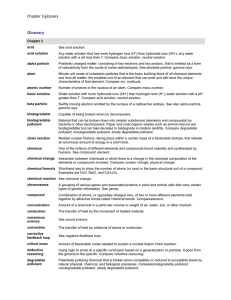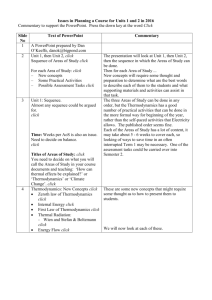File
advertisement
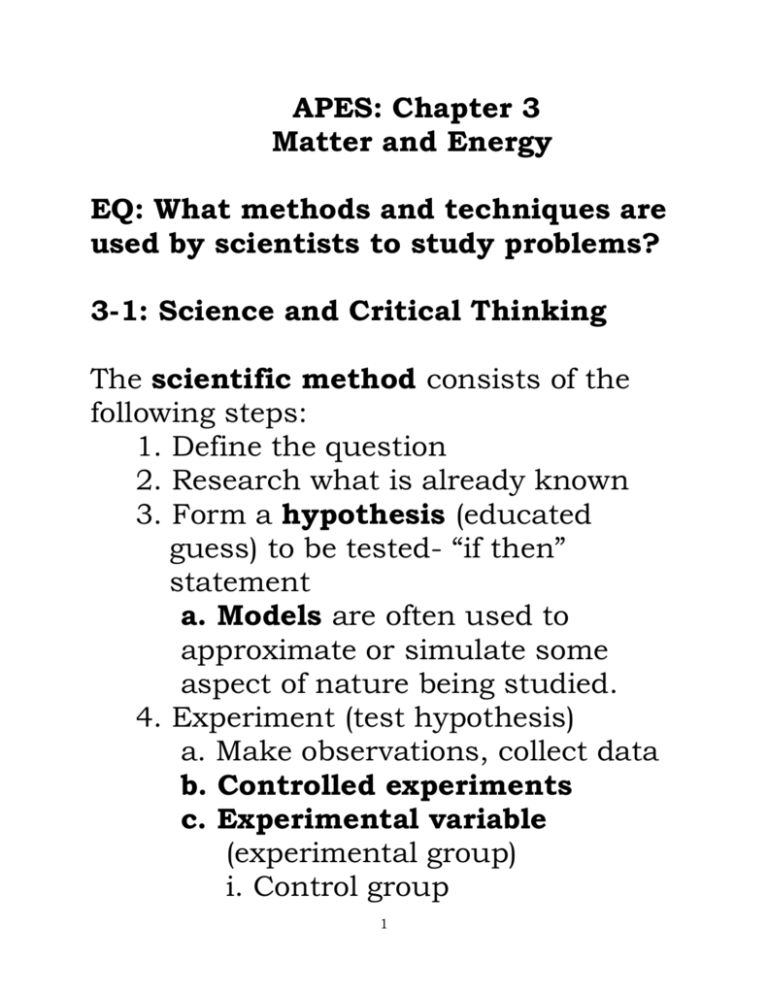
APES: Chapter 3 Matter and Energy EQ: What methods and techniques are used by scientists to study problems? 3-1: Science and Critical Thinking The scientific method consists of the following steps: 1. Define the question 2. Research what is already known 3. Form a hypothesis (educated guess) to be tested- “if then” statement a. Models are often used to approximate or simulate some aspect of nature being studied. 4. Experiment (test hypothesis) a. Make observations, collect data b. Controlled experiments c. Experimental variable (experimental group) i. Control group 1 5. Draw conclusions (laws and theories) a. Theories: concept supported by a large number of experiments b. Law: an explanation or description of how nature works http://www.youtube.com/watch?v=zGgIdrD20do Scientists frequently use one of two types of reasoning to solve scientific problems. Inductive reasoning involves the use of observation, measurement, and previous experience to arrive at a general hypothesis. Deductive reasoning involves an ifthen (logic) statement. HW #1: Chapter Review (page 61-62) #’s: 3 (all terms), 4, 5, 6. EQ: How are models and feedback loops applicable to the study of environmental science? 2 3-2 Models and Behavior of Systems A system is a set of components that function and interact in a theoretically predictable manner (mechanism) and can be isolated for the purpose of study (reductionism). Models (approximate representations of real systems) can be used to study systems or test a hypothesis. Models in the environmental sciences are frequently mathematical (consisting of equations). It is important to remember that models are only as good as the information used to construct them. Systems undergo changes when output (matter, energy, or information) is fed back into the systems as input. Positive feedback causes the system to continue to change in the same direction. 3 https://www.youtube.com/watch?v=FM0hczFNDZI Negative feedback leads to a slowing down or reversal of the change. http://www.youtube.com/watch?v=_QbD92p_EVs Time delays are often found in complex systems. Time delays may allow a problem to build up slowly until a threshold level is reached. (filling a cup with water until it overflows) 4 Synergistic interactions occur when two or more processes interact to have an effect greater than either would separately. Antagonist interactions tend to cancel or mediate each other. Chaotic events tend to be unforeseen or unpredictable (earthquakes). EQ: How is the concept of matter quality important to the study of the problems we face on the planet? Section 3-3 Matter is defined as anything that takes up space and has mass. Matter is found in two chemical forms: Elements: pure substances in which every atom is identical (Periodic Table) 5 Compounds: two or more different elements held together by a chemical bond. The smallest part of element is an atom while the smallest part of compound is a molecule. Atoms and molecules can exist as charged particles known as ions. Compounds are frequently classified as being organic (carbon-based) or inorganic (lacking carbon). Important organic compounds include hydrocarbons, chlorinated hydrocarbons, 6 chloroflurocarbons, carbohydrates, lipids, proteins, and nucleic acids. Important inorganic compounds include salts, water, and numerous air pollutants. http://www.youtube.com/watch?v=w0MWbjIH_Lc#t=62 Matter quality is a measure of how useful a form of matter is to us based upon its availability and concentration. High Quality - concentrated - found near the Earth’s surface Low Quality - dilute - deep underground or in ocean Material efficiency (resource productivity) refers to the amount of material needed to produce each unit of a good or service. In developed countries material efficiency is extremely low (2-6%). HW #2: Review Questions #’ 8, 9, 11, 12. 7 EQ: What are the major ways in which energy is transferred and how is this related to the concept of energy quality? 3-4 Energy: Forms and Quality Energy is defined as the ability to do work and transfer heat. There are two major types of energy: kinetic (energy of motion) and potential (stored energy). Heat is the total amount of kinetic energy a substance has while temperature is the average kinetic energy. 8 Heat is transferred in three major ways, conduction (through contact), convection (through the movement of heated material), and radiation. Radiation is the transfer of energy through space as particles or waves. Electromagnetic radiation occurs in many different forms based upon wavelength. http://www.youtube.com/watch?v=cfXzwh3KadE Energy quality is a measure of an energy source’s ability to do work. High quality energy is concentrated and can perform large amounts of work (electricity, coal, gasoline, uranium-235). Low quality energy is typically dispersed (the total amount of heat in the ocean). 9 EQ: How are the problems of pollution related to the Law of Conservation of Matter? 3-5 Physical and Chemical Changes and the Law of Conservation of Matter Physical changes do not involve a change in the chemical composition of a substance while chemical changes do. Various elements and compounds can be changed from one physical or chemical form to another but we cannot create or destroy any of the atoms involved (Law of Conservation of Matter). There is no away in throw away. Therefore we must always deal with certain pollutants the severity of which depends upon three factors: 10 1- Chemical nature 2- Concentration – usually expressed in parts per million 3- Persistence – how long the pollutant stays around Pollutants are classified based upon their persistence. 1. degradable or nonpersistent (biodegradable if they can be broken down by biological processes: like human sewage) 2. persistent- decades to degradeinsecticides, most plastics 3. Nondegradable - lead, mercury, arsenic HW. #3: Review Questions: 21, 22, 23, 24, 25. EQ: How is the process of nuclear fission similar/different to the process of nuclear fusion. 3-6 Nuclear Changes 11 In addition to undergoing physical and chemical change matter can undergo nuclear decay. This occurs when unstable isotopes is emitted as radiation and can be extremely dangerous causing both genetic (DNA) damage and tissue (burns, miscarriages) damage. The amount of time it takes for an unstable isotope (parent) to decay to a stable form (daughter) is expressed in terms of a half-life. The relationship is indirect and exponential. Use ratio’s to solve: 1half-life Time of half life = # of half-lives given amount of time Nuclear fission occurs when atoms are split causing a chain reaction once a critical mass is achieved. http://www.youtube.com/watch?v=mBdVK4cqiFs#t=50 12 Nuclear fusion occurs when atoms are joined. http://www.youtube.com/watch?v=Cb8NX3HiS4U EQ: In what major ways do the Laws of Thermodynamics impact on the 13 environmental problems we face on planet Earth? 3-7 Two Laws Governing Energy Changes The First Law of Thermodynamics states that during changes in matter, energy is neither created nor destroyed although it might change from one form to another. Energy input is always equal energy output. Energy Input = Energy Output (We can never get more energy out of a system than we put in). The Second Law of Thermodynamics states that when energy is changed from one form to another some of it is always degraded to a lower form (usually heat). We can never recycle high quality energy to do work. Energy Input Quality> Energy Output Quality 14 Energy efficiency is a measure of the amount of useful work is accomplished by the input of a particular amount of energy. Ecosystems have efficiencies of about 10%. 3-8 Matter and Energy Change Laws and Environmental Problems. Because of the law of the conservation of matter and the laws of thermodynamics it is clear that the use of resources always adds waste heat and waste matter to the environment. Modern industrialized countries tend to be high-waste societies because they attempt to maintain economic growth by increasing the flow of matter and energy into the system. Matter-recycling economies attempt to allow for economic growth without depleting material resources. What is the problem with matter-recycling economies? 15 The only long-term (sustainable) solution is to switch to a low-waste economy. HW. #4. Review Questions #’s 27, 29, 31, 32, 33. 16 17
